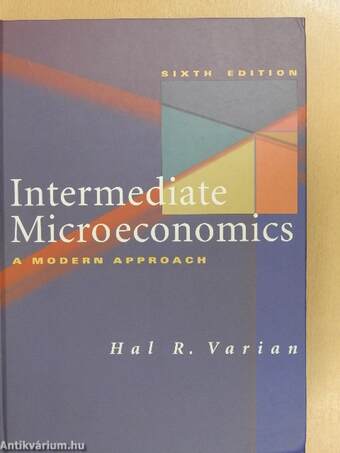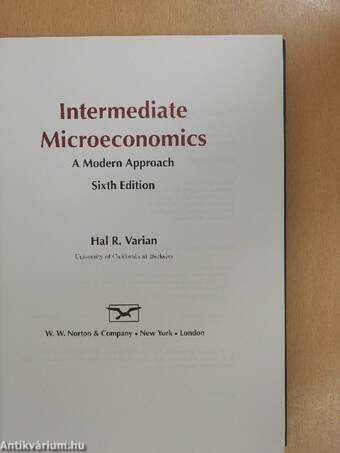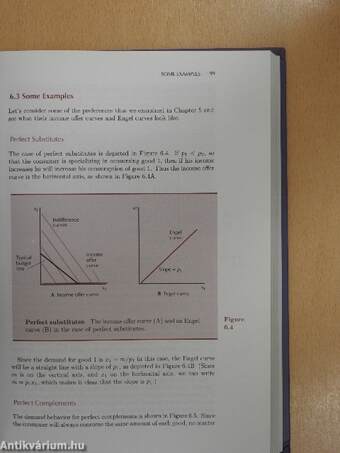1.116.679
kiadvánnyal nyújtjuk Magyarország legnagyobb antikvár könyv-kínálatát
Intermediate Microeconomics
A modern approach
| Kiadó: | W. W. Norton&Company, Inc. |
|---|---|
| Kiadás helye: | |
| Kiadás éve: | |
| Kötés típusa: | Fűzött kemény papírkötés |
| Oldalszám: | 728 oldal |
| Sorozatcím: | |
| Kötetszám: | |
| Nyelv: | Angol |
| Méret: | 24 cm x 18 cm |
| ISBN: | 0-393-97830-3 |
| Megjegyzés: | Színes ábrákkal. |
naponta értesítjük a beérkező friss
kiadványokról
naponta értesítjük a beérkező friss
kiadványokról
Előszó
PREFACE
The success of the first five editions of Intermediate Microeconomics has pleased me very much. It has confirmed my belief that the market would welcome an analytic approach to... Tovább
Előszó
PREFACE
The success of the first five editions of Intermediate Microeconomics has pleased me very much. It has confirmed my belief that the market would welcome an analytic approach to microeconomics at the undergraduate level.
My aim in writing the first edition was to present a treatment of the methods of microeconomics that would allow students to apply these tools on their own and not just passively absorb the predigested cases described in the text. I have found that the best way to do this is to emphasize the fundamental conceptual foundations of microeconomics and to provide concrete examples of their application rather than to attempt to provide an encyclopedia of terminology and anecdote.
A challenge in pursuing this approach arises from the lack of mathematical prerequisites for economics courses at many colleges and universities. The lack of calculus and problem-solving experience in general makes it difficult to present some of the analytical methods of economics. However, it is not impossible. One can go a long way with a few simple facts about linear demand functions and supply functions and some elementary algebra. It is perfectly possible to be analytical without being excessively mathematical.
The distinction is worth emphasizing. An analytical approach to economics is one that uses rigorous, logical reasoning. This does not necessarily require the use of advanced mathematical methods. The language of mathematics certainly helps to ensure a rigorous analysis and using it is undoubtedly the best way to proceed when possible, but it may not be appropriate for all students. Vissza
Tartalom
CONTENTS
Preface
1 The Market
Constructing a Model 1 Optimization and Equilibrium 3 The Demand Curve 3 The Supply Curve 5 Market Equilibrium 7 Comparative Statics 9 Other Ways to Allocate Apartments 11 The Discriminating Monopolist • The Ordinary Monopolist • Rent Control Which Way Is Best? 14 Pareto Efficiency 15 Comparing Ways to Allocate Apartments 16 Equilibrium in the Long Run 17 Summary 18 Review Questions 19
2 Budget Constraint
The Budget Constraint 20 Two Goods Are Often Enough 21 Properties of the Budget Set 22 How the Budget Line Changes 24 The Numeraire 26 Taxes, Subsidies, and Rationing 26 Example: The Food Stamp Program Budget Line Changes 31 Summary 31 Review Questions 32
VIII CONTENTS
3 Preferences
Consumer Preferences 34 Assumptions about Preferences 35 Indifference Curves 36 Examples of Preferences 37 Perfect Substitutes
• Perfect Complem.ents • Dads • Neutrals • Satiation • Discrete Goods Weil-Behaved Preferences 44 The Marginal Rate of Substitution 48 Other Interpretations of the MRS 50 Behavior of the MRS 51 Summary 52 Review Questions 52
4 Utility
Cardinal Utility 57 Constructing a Utility Fmiction 58 Some Examples of Utility Fimctions 59 Example: Indifference Curves from. Utility • Perfect Substitutes • Perfect Complements • Quasilinear Preferences
• Cobb-Douglas Preferences Marginal Utility 65 Marginal Utility and l\fRS 66 Utility for Commuting 67 Summary 69 Review Questions 70 Appendix 70 Example: Cobb-Douglas Preferences
5 Choice
Optimal Choice 73 Consumer Demand 78 Some Examples 78 Perfect Substitutes • Perfect Complements • Neutrals and Bads • Discrete Goods • Concave Preferences • Cobb-Douglas Preferences Estimating Utility Fvmctions 83 Imphcations of the MRS Condition 85 Choosing Taxes 87 Suuunary 89 Review Questions 89 Appendix 90 Example: Cobb-Douglas Demand Functions
6 Demand
Normal and Inferior Goods 96 Income Offer Curves and Engel Curves 97 Some Examples 99 Perfect Substitutes • Perfect Com.plcjnents
• Cobb-Douglas Preferences • Homothetic Preferences • Quasilinear Preferences Ordinary Goods and Giffen Goods 104 The Price Offer Curve and the Demand Curve 106 Some Examples 107 Perfect Substitutes • Perfect Com.plernents • A Discrete Good Substitutes and Com])lements 111 The Inverse Demand Function 112 Summary 114 Review Questions 115 Ajipeiidix 115
CONTENTS IX
7 Revealed Preference
The Idea of Revealed Preference 119 From Revealed Preference to Preference 120 Recovering Preferences 122 The Weak Axiom of Revealed Preference 124 Checking WARP 125 The Strong Axiom of Revealed Preference 128 How to Check SARP 129 Index Numbers 130 Price Indices 132 Example: Indexing Social Security Payments Summary 135 Review Questions 135
8 Slutsky Equation
The Substitution Effect 137 Example: Calculating the Substitution Effect The Income Effect 141 Example: Calculating the Income Effect Sign of the Substitution Effect 142 The Total Change in Demand 143 Rates of Change 144 The Law of Demand 147 Examples of Income and Substitution Effects 147 Example: Rebating a Tax • Example: Voluntary Real Time Pricing Another Substitution Effect 153 Compensated Demand Curves 155 Summary 156 Review Questions 157 Appendix 157 Example: Rebating a Small Tax
9 Buying and Selling
Net and Gross Demands 160 The Budget Constraint 161 Changing the Endowment 163 Price Changes 164 Offer Curves and Demand Cm-ves 167 The Slutsky Equation Revisited 168 Use of the Slut-sky Equation 172 Example: Calcidating the Endowment Income Effect Labor Sui)ply 173 The Budget Constraint Comparative Statics of La])or Supply 174 E:r,a,mple: Overtime and the Supply of Labor Summary 178 Review (Questions 179 Appendix 179
X CONTENTS
10 Intertemporal Choice
The Budget Constraint 182 Preferences for Coiisiunption 185 Comparative Statics 186 The Shitsky Equation and Intertemporal Choice 187 Inflation 189 Present Value: A Closer Look 191 Analyzing-Present Value for Several Periods 193 Use of Present Value 194 Ex-am.ple: Valuing a Stream of Payments • Example: The True Cost of a Credit Card Bonds 197 Example: Installment Loans Taxes 199 Exam,pie: Scholarships and Savings Choice of the Interest Rate 200 Sunniiary 201 Review Questions 201
11 Asset Markets
Rates of Return 202 Arbitrage and Present Vahie 204 Adjustments for Differences among Assets 204 Assets with Consumption Returns 205 Taxation of Asset Returns 206 Applications 207 Depletable Resources • When to Cut a Forest • Example: Gasoline Prices during the Gulf War Financial Institutions 211 Summary 212 Review Questions 213 Appendix 213
12 Uncertainty
Contingent Consumption 215 Example: Catastrophe Bonds Utihty Functions and Probabilities 220 Example: Some Examples of Utility Functions Expected Utility 221 Why Expected Utility Is Reasonable 222 Risk Aversion 224 Example: The Demand for Insurance Diversification 228 Risk Spreading 228 Role of the Stock Market 229 Suunnary 230 Review Questions 230 Appendix 231 Example: The Effect of Taxation on Investment in Risky Assets
13 Risky Assets
Mean-Variance Utihty 234 Measuring Risk 239 EquiUbrium in a Market for Risky Assets 241 How Returns Adjust 242 Example: Ranking Mutual Funds Sunnnary 246 Review Questions 246
CONTENTS XI
14 Consumer's Surplus
Demand for a Discrete Good 248 Constructing Utility from Demand 249 Other Interpretations of Consumer's Surplus 250 From Consumer's Surplus to Consumers' Surplus 251 Approximating a Continuous Demand 251 Quasilinear Utility 251 Interpreting the Change in Consumer's Surplus 252 Example: The Change in Consumer's Surplus Compensating and Equivalent Variation 254 Example: Compensating and Equivalent Variations • Example: Compensating and Equivalent Variation for Quasilinear Preferences Producer's Surplus 258 Benefit-Cost Analysis 260 Rationing Calculating Gains and Losses 262 Summary 263 Review Questions 263 Appendix 264 Example: A Few Demand Functions • Example: CV, EV, and Consumer's Surplus
15 Market Demand
From Individual to Market Demand 266 The Inverse Demand Function
268 Example: Adding Up "Linear" Demand Curves Discrete Goods
269 The Extensive and the Intensive Margin 269 Elasticity 270 Example: The Elasticity of a Linear Demand Curve Elasticity and Demand 272 Elasticity and Revenue 273 Example: Strikes and Profits Constant Elasticity Demands 276 Elasticity and Marginal Revenue 277 Example: Setting a Price Marginal Revenue Curves 279 Income Elasticity 280 Summary 281 Review Questions 282 Appendix 283 Example: The Laffer Curve • Example: Another Expression for Elasticity
16 Equilibrium
Supply 289 Market Equilibrium 289 Two Special Cases 290 Inverse Demand and Supply Curves 291 Example: Equilibrium with Linear Curves Comparative Statics 293 Example: Shifting Both Curves Taxes 294 Example: Taxation with Linear Demand and Supply Passing Along a Tax 298 The Deadweight Loss of a Tax 300 Example: The Market for Loans • Example: Food Subsidies Pareto Efficiency 306 Example: Waiting in Line Summary 308 Review Questions 309
XII CONTENTS
17 Auctions
Classification of Auctions 311 Bidding Rules Auction Design 312 Other Auction Forms 315 Problems with Auctions 316 The Winner's Curse 317 Summary 318 Review Questions 318
18 Technology
Inputs and Outputs 319 Describing Technological Constraints 320 Examples of Technology 321 Fixed Proportions • Perfect Substitutes • Cobb-Douglas Properties of Technology 323 The Marginal Product 325 The Technical Rate of Substitution 325 Diminishing Marginal Product 326 Diminishing Technical Rate of Substitution 326 The Long Run and the Short Run 327 Returns to Scale 327 Summary 329 Review Questions 330
19 Profit Maximization
Profits 331 The Organization of Firms 333 Profits and Stock Market Value 333 Fixed and Variable Factors 335 Short-Run Profit Maximization 335 Comparative Statics 337 Profit Maximization in the Long Run 338 Inverse Factor Demand Curves 339 Profit Maximization and Returns to Scale 340 Revealed Profitability 341 Example: How Do Farmers React to Price Supports? Cost Minimization 345 Summary 345 Review Questions 346 Appendix 347
20 Cost Minimization
Cost Minimization 349 Example: Minimizing Costs for Specific Technologies Revealed Cost Minimization 353 Returns to Scale and the Cost Function 354 Long-Rim and Short-Run Costs 356 Fixed and Quasi-Fixed Costs 358 Sunk Costs 358 Summary 359 Review Questions 359 Appendix 360
¦ • 1 . i 1 i, ' -'- '' '' "li HiilitM CONTENTS XIII
21 Cost Curves
Average Costs 363 Marginal Costs 365 Marginal Costs and Variable Costs 367 Example: Specific Cost Curves • Example: Marginal Cost Curves for Two Plants Long-Run Costs 371 Discrete Levels of Plant Size 373 Long-Run Marginal Costs 375 Summary 376 Review Questions 377 Appendix 377
22 Firm Supply
Market Environments 379 Pure Competition 380 The Supply Decision of a Competitive Firm 382 An Exception 384 Another Exception 385 Example: Pricing Operating Systems The Inverse Supply Function 387 Profits and Producer's Surplus 387 Example: The Supply Curve for a Specific Cost Function The Long-Run Supply Curve of a Firm 391 Long-Run Constant Average Costs 393 Summary 394 Review Questions 395 Appendix 395
23 Industry Supply
Short-Run Industry Supply 397 Industry Equilibrium in the Short Run 398 Industry Equilibrium in the Long Run 399 The Long-Run Supply Curve 401 Example: Taxation in the Long Run and in the Short Rim The Meaning of Zero Profits 405 Fixed Factors and Economic Rent 406 Example: Taxi Licenses in New York City Economic Rent 408 Rental Rates and Prices 410 Example: Liquor Licenses The Politics of Rent 411 Example: Farming the Government Energy Pohcy 413 Two-Tiered Oil Pricing • Price Controls • The Entitlement Program Summary 417 Review Questions 418
XIV CONTENTS
24 Monopoly
Maximizing Profits 420 Linear Demand Curve and Monopoly 421 Markup Pricing 423 Example: The Impact of Taxes on a Monopolist Inefficiency of Monopoly 425 Deadweight Loss of Monopoly 427 Example: The Optimal Life of a Patent Natural Monopoly 430 What Causes Monopolies? 432 Example: Diamonds Are Forever • Example: Pooling in Auction Markets Summary 435 Review Questions 436 Appendix 437
25 Monopoly Behavior
Price Discrimination 439 First-Degree Price Discrimination 439 Second-Degree Price Discrimination 441 Example: Price Discrimination in Airfares Third-Degree Price Discrimination 445 Example: Linear Demand Curves • Example: Calculating Optimal Price Discrimination • Example: Price Discrimination in Academic Journals Bundling 449 Example: Software Suites Two-Part Tariffs 451 Monopolistic Competition 453 A Location Model of Product Differentiation 456 Product Differentiation 458 More Vendors 458 Summary 459 Review Questions 460
26 Factor Markets
Monopoly in the Output Market 461 Monopsony 464 Example: The Minimum Wage Upstream and Downstream Monopolies 468 Summary 470 Review Questions 471 Appendix 471
CONTENTS XV
27 Oligopoly
Choosing a Strategy 474 Quantity Leadership 474 The Follower's Problem • The Leader's Problem Price Leadership 480 Comparing Price Leadership and Quantity Leadership 482 Simultaneous Quantity Setting 482 An Example of Cournot Equilibrium 484 Adjustment to Equilibrium 486 Many Firms in Cournot Equilibrium 486 Simultaneous Price Setting 487 Collusion 488 Punishment Strategies 491 Example: Price Matching and Competition • Example: Voluntary Export Restraints Comparison of the Solutions 494 Summary 495 Review Questions 496
28 Game Theory
The Payoff Matrix of a Game 497 Nash Equilibrium 499 Mixed Strategies 500 The Prisoner's Dilemma 501 Repeated Games 503 Enforcing a Cartel 505 Example: Tit for Tat in Airline Pricing Sequential Games 506 A Game of Entry Deterrence 509 Summary 510 Review Questions 511
29 Game Applications
Best Response Curves 512 Mixed Strategies 514 Games of Coordination 516 Battle of the Sexes • Prisoner's Dilemma • Assurance Games • Chicken • How to Coordinate Games of Competition 520 Games of Coexistence 525 Games of Commitment 527 The Frog and the Scorpion • The Kindly Kidnapper • When Strength Is Weakness • Savings and Social Security • Hold Up Bargaining 535 The Ultimatum Game Summary 538 Review Questions 539
XVI CONTENTS
30 Exchange
The Edgeworth Box 541 Trade 543 Pareto Efficient Allocations 544 Market Ti-ade 546 The Algebra of Equilibrium 548 Walras' Law 550 Relative Prices 551 Example: An Algebraic Example of Equilibrium The Existence of Equilibrium 553 Equilibrium and Efficiency 554 The Algebra of Efficiency 555 Example: Monopoly in the EdgewoHh Box Efficiency and Equilibrium 558 Implications of the First Welfare Theorem 560 Implications of the Second Welfare Theorem 562 Summary 564 Review Questions 565 Appendix 565
31 Production
The Robinson Crusoe Economy 567 Crusoe, Inc. 569 The Firm 570 Robinson's Problem 571 Putting Them Together 571 Different Technologies 573 Production and the First Welfare Theorem 575 Production and the Second Welfare Theorem 576 Production Possibilities 576 Comparative Advantage 578 Pareto Efficiency 580 Castaways. Inc. 582 Robinson and Friday as Consumers 584 Decentralized Resource Allocation 585 Summary 586 Review Questions 586 Appendix 587
32 Welfare
Aggregation of Preferences 590 Social Welfare Functions 592 Welfare Maximization 594 Individualistic Social Welfare Functions 596 Fair Allocations 597 Envy and Equity 598 Summary 600 Review Questions 600 Appendix 601
33 Externalities
Smokers and Nonsmokers 603 Quasilinear Preferences and the Coase Theorem 606 Production Externalities 608 Example: Pollution Vouchers Interpretation of the Conditions 613 Market Signals 616 The Tragedy of the Commons 616 Example: Overfishing Automoljile Pollution 620 Summary 621 Review Questions 622
CONTENTS XVII
34 Information Technology
Systems Competition 624 The Problem of Complements 624 Relationships am.ong Com.plementors Lock-In 628 A Model of Competition with Switching Costs Network Externalities 631 Markets with Network Externalities 631 Market Dynamics 633 Example: Network Externalities in Computer Software Implications of Network Externalities 637 Rights Management 637 Exam,pie: Video Rental Sharing Intellectual Property 639 Summary 641 Review Questions 642
35 Public Goods
When to Provide a Public Good? 644 Private Provision of the Public Good 648 Free Riding 648 Different Levels of the Public Good 650 Quasilinear Preferences and Public Goods 652 Example: Pollution Revisited The Free Rider Problem 654 Comparison to Private Goods 656 Voting 657 Example: Agenda Manipulation Demand Revelation 660 Example: An Example of the Clarke Tax Problems with the Clarke Tax 664 Summary 665 Review Questions 665 Appendix 666
36 Asymmetric Information
The Market for Lemons 668 Quality Choice 669 Choosing the Quality • Adverse Selection 671 Moral Hazard 673 Moral Hazard and Adverse Selection 674 Signaling 675 Example: The Sheepskin Effect Incentives 679 Exam,pie: Voting Rights in the Corporation • Exa,m-ple: Chinese Economic Reforms Asymmetric Information 684 Example: Monitoring Costs • Exam.ple: The Grameen Bank Summary 687 Review Questions 688
XVIII CONTENTS
Mathematical Appendix
Functions Al Graphs A2 Properties of Functions A2 Inverse Functions A3 Equations and Identities A3 Linear Functions A4 Changes and Rates of Change A4 Slopes and Intercepts A5 Absolute Values and Logarithms A6 Derivatives A6 Second Derivatives A7 The Product Rule and the Chain Rule A8 Partial Derivatives A8 Optimization A9 Constrained Optimization AlO
Answers Index
All
A31
Témakörök
- Közgazdaságtan > Általános > Mikroökonómia
- Idegennyelv > Idegennyelvű könyvek > Angol > Egyéb
- Idegennyelv > Idegennyelvű könyvek > Angol > Közgazdaságtan > Általános > Mikroökonómia
- Közgazdaságtan > Tankönyvek, jegyzetek, szöveggyűjtemények > Felsőoktatási
- Idegennyelv > Idegennyelvű könyvek > Angol > Közgazdaságtan > Tankönyvek, jegyzetek, szöveggyűjtemények > Felsőoktatási
- Tankönyvek, jegyzetek, szöveggyűjtemények > Közgazdaságtudomány > Felsőoktatási











